Intel X25-V in RAID-0: Faster than X25-M G2 for $250?
by Anand Lal Shimpi on March 29, 2010 8:59 PM ESTOverall System Performance using PCMark Vantage
Next up is PCMark Vantage, another system-wide performance suite. For those of you who aren’t familiar with PCMark Vantage, it ends up being the most real-world-like hard drive test I can come up with. It runs things like application launches, file searches, web browsing, contacts searching, video playback, photo editing and other completely mundane but real-world tasks. I’ve described the benchmark in great detail before but if you’d like to read up on what it does in particular, take a look at Futuremark’s whitepaper on the benchmark; it’s not perfect, but it’s good enough to be a member of a comprehensive storage benchmark suite. Any performance impacts here would most likely be reflected in the real world.

Intel had been falling behind in the PCMark Vantage charts thanks to the SandForce and Crucial drives, but RAIDing these two X25-Vs makes up for a lot of lost time. Overall performance is basically on par with the entry level SandForce drives, but behind the C300 on a 6Gbps controller. The rest of the tests have the X25-V landing either in the middle or near the top of the charts, not bad for $250.
The memories suite includes a test involving importing pictures into Windows Photo Gallery and editing them, a fairly benign task that easily falls into the category of being very influenced by disk performance.
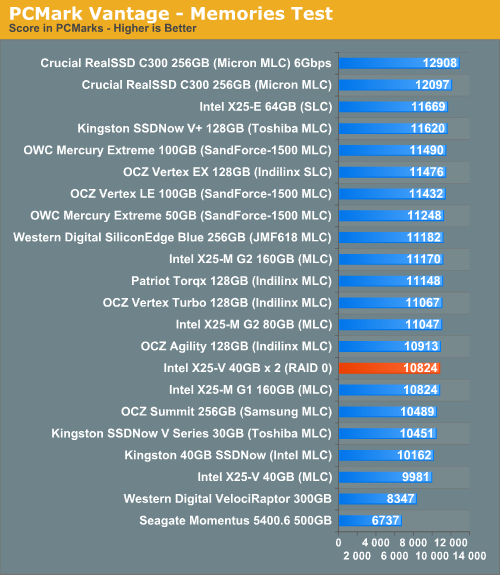
The TV and Movies tests focus on on video transcoding which is mostly CPU bound, but one of the tests involves Windows Media Center which tends to be disk bound.
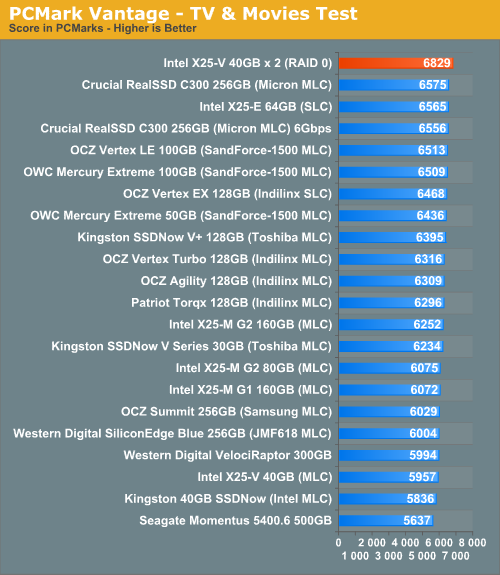
The gaming tests are very well suited to SSDs since they spend a good portion of their time focusing on reading textures and loading level data. All of the SSDs dominate here, but as you'll see later on in my gaming tests the benefits of an SSD really vary depending on the game. Take these results as a best case scenario of what can happen, not the norm.
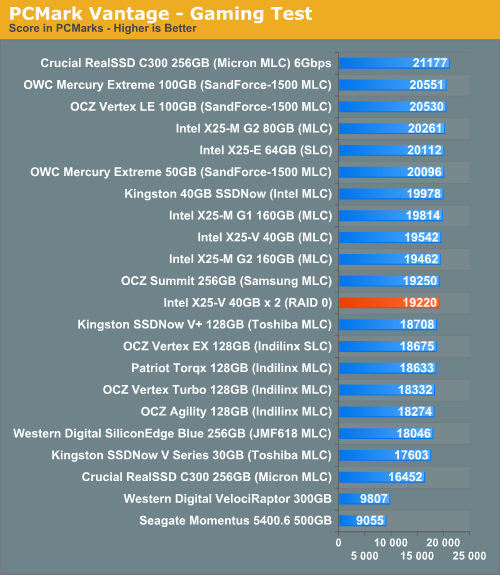
In the Music suite the main test is a multitasking scenario: the test simulates surfing the web in IE7, transcoding an audio file and adding music to Windows Media Player (the most disk intensive portion of the test).
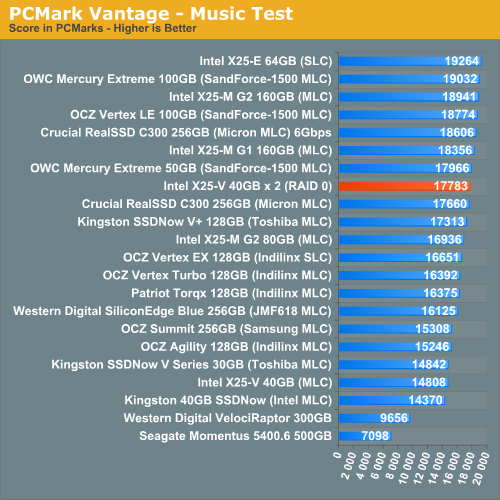
The Communications suite is made up of two tests, both involving light multitasking. The first test simulates data encryption/decryption while running message rules in Windows Mail. The second test simulates web surfing (including opening/closing tabs) in IE7, data decryption and running Windows Defender.
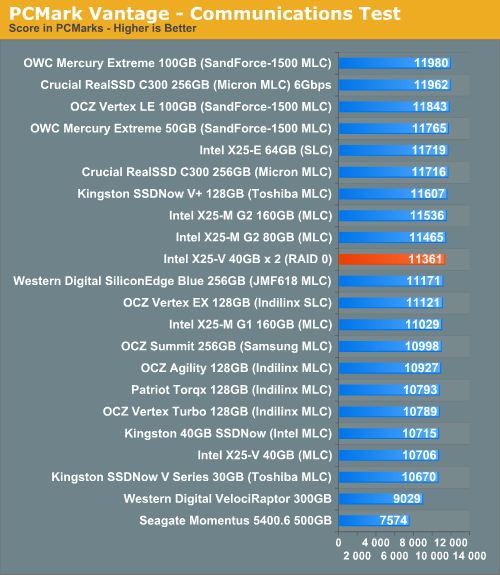
I love PCMark's Productivity test; in this test there are four tasks going on at once, searching through Windows contacts, searching through Windows Mail, browsing multiple webpages in IE7 and loading applications. This is as real world of a scenario as you get and it happens to be representative of one of the most frustrating HDD usage models - trying to do multiple things at once. There's nothing more annoying than trying to launch a simple application while you're doing other things in the background and have the load take forever.
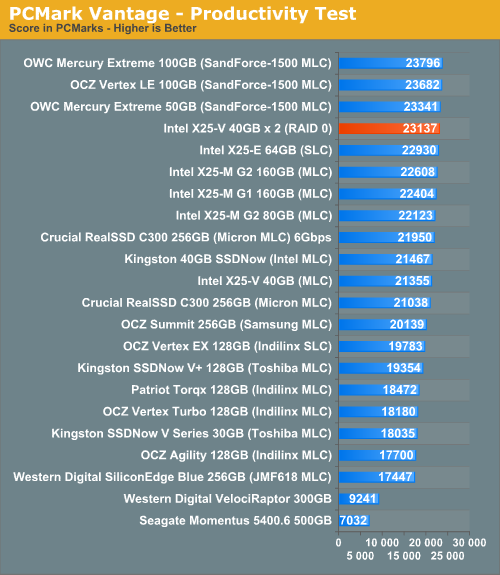
The final PCMark Vantage suite is HDD specific and this is where you'll see the biggest differences between the drives:











87 Comments
View All Comments
GullLars - Thursday, April 1, 2010 - link
I think TRIM works i IDE mode also, i remember reading that both drivers PCIIDE and MSAHCI supports TRIM. However, this is not the big problem with using IDE mode, the problem is the loss of NCQ, so your performance don't scale with load. Your SSD will essentially only be able to do about 20MB/s at 4KB random read, while it can do 120MB/s random read with NCQ enabled (at fairly high load, like launching multiple apps simultaneously).buzznut - Thursday, April 1, 2010 - link
Thanks for the reply. I have been considering getting a new mobo anyway, I think I'd like to get a 890gx with the new interfaces.Only pb there is I have ddr2 ram and am2 cpus. doh
Guess I'll wait til some money comes in to do any upgrading...
Elganja - Friday, April 2, 2010 - link
"Update (03/29/2010): Intel has recently released a new driver that allows Windows 7’s TRIM instructions to be passed through the Southbridge. The new driver is labeled "Rapid Storage Technology 9.6" and it can be found here. These drivers are also able to pass TRIM commands to RAID 0 and RAID 1 arrays. "jed22281 - Saturday, April 3, 2010 - link
TT is mistaken, there is no support for drives combined into RAID volumes.There is for individual drives connected to the controller while it's in RAID mode.
http://www.intel.com//support/chipsets/imsm/sb/CS-...
Also see
http://communities.intel.com/community/tech/solids...
Look for the gold star at the top of the page, select show details and then go to announcement 2.
"Intel® RST 9.6 supports TRIM in AHCI and pass through modes for RAID. A bug has been submitted to change the string that indicates TRIM is supported on RAID volumes (0, 1, 5, 10). Intel is continuing to investigate the ability of providing TRIM support for all RAID volumes in a future release."
Chloiber - Sunday, April 4, 2010 - link
A colleague from another HW site asked Intel directly. It's definitely NOT SUPPORTED (just to point that out again). It's clearly a mistake of intel, as they didn't make themselves clear in the change logs/readmes and even in the rapid storage manager itself it's not clear.Here is what they said btw:
"It will support TRIM with SSDs in an AHCI configuration, or with the RAID controller enabled and the SSD is used as a pass through device. An example of this use case is for users that want to use the SSD as a boot drive but still be able to RAID multiple HDDs together to allow for large protect data storage – a great use for the home theater PC."
No RAID0 or anything. "Just" simple TRIM as we're used to from the MSAHCI drivers.
Elganja - Friday, April 2, 2010 - link
The quote was from this article: http://www.tweaktown.com/articles/3116/tweaktown_s...morphin1 - Friday, April 2, 2010 - link
What do you mean by doing sequential write?How would you do that?
Also will this apply to the new Sony Vaio Z series laptops SSD's that come in Raid 0 config?
Is it recommended to buy a laptop in Raid 0 config with SSD's as over time they might become snails.
Do you see the chance of Trim being supported on current SSD's in the near future?
Thanks a lot in advance.
GullLars - Saturday, April 3, 2010 - link
Sequential writes are the type of writes that typically occur when you save or copy large files (1MB or larger).As for RAID in sony Vaio. There is no way of telling if it will become snail-like whitout knowing wich SSD is in the laptop in question. If it's Intel, Sandforce, or C300, it sould be just fine, if it's some low-quality cheap SSD from last generation drives, or the crap they put in the netbooks last year, it will go really bad.
jed22281 - Saturday, April 3, 2010 - link
You mean if it's:Postville (Intel), SF-1200/1500 (Sandforce), C300 (JMicron), or Barefoot (Indilinx)
GullLars - Saturday, April 3, 2010 - link
I forgot barefoot, my bad.